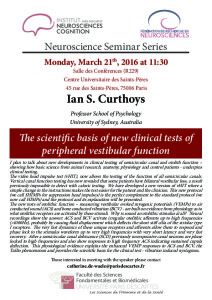Neuroscience Seminar Series :
Ian S. Curthoys – Professor School of Psychology, University of Sydney, Australia
‘The scientific basis of new clinical tests of peripheral vestibular function’
![]() Video of the event (restricted to Paris descartes members).
Video of the event (restricted to Paris descartes members).
I plan to talk about new developments in clinical testing of semicircular canal and otolith function –showing how basic science from animal research, anatomy, physiology and control patients – underpins clinical testing.
The video head impulse test (vHIT), now allows the testing of the function of all semicircular canals. Vertical canal function testing has now revealed that some patients have bilateral vestibular loss, a result previously impossible to detect with caloric testing. We have developed a new version of vHIT where a simple change in the instructions makes the test easier for the patient and the clinician. This new protocol (we call SHIMPs for suppression head impulses) is the perfect complement to the standard protocol (we now call HIMPs) and the protocol and its explanation will be presented.
The new tests of otolithic function – measuring vestibular evoked myogenic potentials (VEMPs) to air conducted sound (ACS) and bone conducted vibration (BCV) – are built on evidence from physiology as to what otolithic receptors are activated by these stimuli. Why is sound an otolithic stimulus at all? Neural recordings show the answer: ACS and BCV activate irregular otolithic afferents up to high frequencies (>1000Hz), probably by causing fluid displacement which deflects the short stiff cilia of the striolar type I receptors. The very fast dynamics of these unique receptors and afferents allow them to respond and phase lock to the stimulus waveform up to very high frequencies with very short latency and very fast recovery. After a semicircular canal dehiscence (SCD) previously unresponsive canal neurons are phase locked to high frequencies and also show responses to high frequency ACS indicating sustained cupula deflection. This physiological evidence explains the enhanced VEMP responses to ACS and BCV, the Tullio phenomenon and provides the scientific basis for the clinical test – vibration induced nystagmus.

